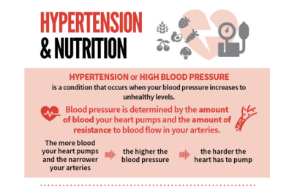WHF publish new roadmap for hypertension
The WHF have created a new infographic for patients and roadmap for professionals, providing practical advice for tackling high blood pressure
The World Heart Federation (WHF) have published a new roadmap for hypertension (high blood pressure) that provides health professionals and policy makers with evidence-based guidelines for preventing, diagnosing and managing high blood pressure. They’ve also released a helpful new infographic on high blood pressure and nutrition in partnership with LoSalt® (the UK’s leading reduced-sodium salt), for those who want to take care of their own blood pressure.

A new infographic on high blood pressure and nutrition
LoSalt®, who are Blood Pressure UK supporters and sponsors of the #SeasonWithSense public health awareness campaign helped to develop the new infographic, which provides a snapshot showing how simple steps can go a long way to lowering your blood pressure. Replacing regular salt with a reduced sodium alternative can be a key part of that – as sodium raises blood pressure.
Take a look at the new infographic to see some of the ways you can lower your blood pressure through diet and a healthy lifestyle.
A new roadmap for health professionals and policy makers worldwide
The roadmap complements new treatment guidelines published by the WHO this August, providing practical suggestions for health professionals, supporting them to put the new guidelines into practice. It comes as new figures show 1.28 billion people worldwide now have high blood pressure and over half of these are not having treatment.
High blood pressure can lead to diseases of the heart and blood vessels which together cause more than 18.5 million deaths every year, many of which could be prevented with better blood pressure control.
The roadmap is part of the WHF series for preventing diseases of the heart and blood vessels. It was last updated in 2015 and now incorporates important new guidelines and updates in science, policies and technology.
It defines the problems reaching and treating those with high blood pressure, and provides solutions with potential for scalability in low and middle income countries, where high blood pressure is becoming more prevalent. Cost effective medicines and lifestyle interventions do exist but uptake is still low, especially in resource-poor areas.
Key solutions include the following:
- Develop population-wide prevention and control programmes
- Roll out opportunistic screening
- Encourage out-of-office blood pressure measurements (especially home monitoring)
- Strengthen primary care
- Promote and implement task-sharing and team-based care
- Deliver people-centred care
- Strengthen patient and carer education
- Facilitate adherence to pharmacological therapy
- Improve medication supply management for example by including affordable high-quality long-acting evidence-based and preferably single pill combination generic antihypertensive drugs in national lists of essential medicines
- Foster the use of novel technologies, including m-health, e-health and apps.
Hemini Bharadia, Marketing Manager at Blood Pressure UK says: “Eating less salt is one of the simplest and most effective ways to lower your blood pressure, and a reduced sodium salt can play a key part in cutting back if you’re struggling to go without. Importantly, reduced sodium salt substitutes have recently been shown to reduce the risk of stroke and early death, as well as the intermediary step of high blood pressure.”
Phil Pyatt, CEO of Blood Pressure UK says: “High blood pressure is one of the leading causes of strokes and heart attacks both in the UK and worldwide. One of the biggest problems is that people simply don’t know they have it as it usually has no symptoms. We welcome this new roadmap for providing politicians and health professionals with practical ways to get people diagnosed and deliver the most effective treatments.”
